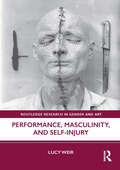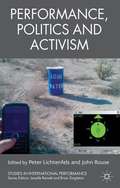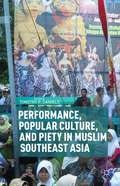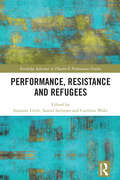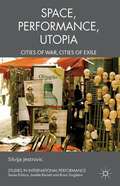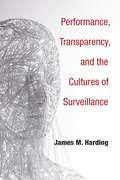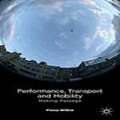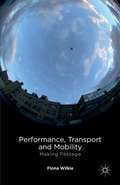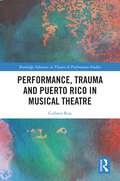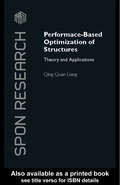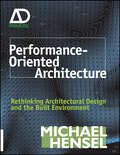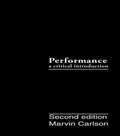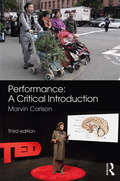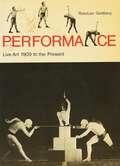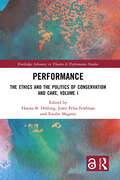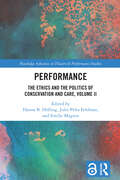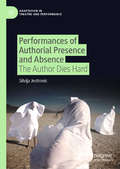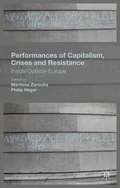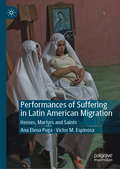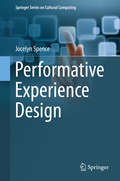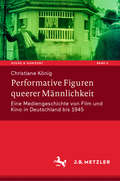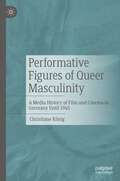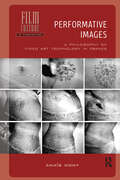- Table View
- List View
Performance, Masculinity, and Self-Injury (Routledge Research in Gender and Art)
by Lucy WeirThis book is an ambitious and expansive examination of the visual language of self-injury in performance art from the 1960s to the present.Inspired by the gendered nature of discussion around self-harm, the book challenges established readings of risk-taking and self-injury in global performance practice. The interdisciplinary methodology draws from art history and sociology to provide a new critical analysis of the relationship between masculinity and self-inflicted injury. Based upon interviews with a range of artists around the world, it offers an innovative understanding of the diverse meanings behind self-injury in performance, and delves into the gendered coding of self-harming bodies. Individual chapters examine the work of Ron Athey, Günter Brus, Wafaa Bilal, Franko B, André Stitt, Pyotr Pavlensky, and Yang Zhichao, offering a new perspective on the forms and functions of self-injury in performance art.The book will be of interest to scholars working in art history, performance studies, gender studies, and cultural studies.
Performance, Politics and Activism
by John Rouse Peter LichtenfelsThis collection of essays on politics, the performing arts, and various forms of activist performance uses the framework of performance studies to explore the engagements of political resistance, public practice and performance media. It places these engagements on various scales of performance production within local, national and transnational structures of neoliberal and liberal government and power. Performance has always been a way of articulating the conditions of contemporary society, and of pointing through the body of the performance to ways of defining, understanding and changing those conditions. Throughout these essays performance takes place in the environments of heightened everyday action, the aesthetic and cultural activity of the performing arts, and in the activist performance of political commitment. These trajectories in performance studies delineate the way people identify themselves and communicate with one another, both in attempts to change the structures of governance they experience, and vitally, alongside those structures.
Performance, Popular Culture, and Piety in Muslim Southeast Asia
by Timothy P. DanielsThe Muslim-majority nations of Malaysia and Indonesia are known for their extraordinary arts and Islamic revival movements. This collection provides an extensive view of dance, music, television series, and film in rural, urban, and mass-mediated contexts and how pious Islamic discourses are encoded and embodied in these public cultural forms.
Performance, Resistance and Refugees (Routledge Advances in Theatre & Performance Studies)
by Suzanne Little Samid Suliman Caroline WakeThis book offers a unique Australian perspective on the global crisis in refugee protection. Using performance as both an object and a lens, this volume explores the politics and aesthetics of migration control, border security and refugee resistance. The first half of the book, titled On Stage, examines performance objects such as verbatim and documentary plays, children’s theatre, immersive performance, slam poetry, video art and feature films. Specifically, it considers how refugees, and their artistic collaborators, assert their individuality, agency and authority as well as their resistance to cruel policies like offshore processing through performance. The second half of the book, titled Off Stage, employs performance as a lens to analyse the wider field of refugee politics, including the relationship between forced migrants and the forced displacement of First Nations peoples that underpins the settler-colonial state, philosophies of cosmopolitanism, the role of the canon in art history and the spectacle of bordering practices. In doing so, it illuminates the strategic performativity—and nonperformativity—of the law, philosophy, the state and the academy more broadly in the exclusion and control of refugees. Taken together, the chapters in this volume draw on, and contribute to, a wide range of disciplines including theatre and performance studies, cultural studies, border studies and forced migration studies, and will be of great interest to students and scholars in all four fields.
Performance, Space, Utopia
by Silvija JestrovicThe war in the Balkans that took place between 1991-1995 forms the context of this book. It has been variously viewed as ethnic strife, religious conflict, or civil war but seldom has it been described as a war against cities. Belgrade and Sarajevo offer a fascinating comparative case study, not only because the two cities belong to the same historical narrative of the breakdown of Yugoslavia, but because of the ways in which their various performances both complement and contradict one another. This book examines how performance and theatricality became modes of being and acting in the city, even strategies of physical and ethical survival; yet so often it is exile, both as marginalisation within and exodus from the city, that emerges as the defining consequence of living in Sarajevo or Belgrade in the 1990s.
Performance, Subjectivity, Cosmopolitanism
by Yana MeerzonThis book looks at the connection between contemporary theatre practices and cosmopolitanism, a philosophical condition of social behaviour based on our responsibility, respect, and healthy curiosity to the other. Advocating for cosmopolitanism has become a necessity in a world defined by global wars, mass migration, and rise of nationalism. Using empathy, affect, and telling personal stories of displacement through embodied encounter between the actor and their audience, performance arts can serve as a training ground for this social behavior. In the centre of this encounter is a new cosmopolitan: a person of divided origins and cultural heritage, someone who speaks many languages and claims different countries as their place of belonging. The book examines how European and North American theatres stage this divided subjectivity: both from within, the way we tell stories about ourselves to others, and from without, through the stories the others tell about us.
Performance, Transparency, and the Cultures of Surveillance
by James M. HardingPlacing the disciplines of performance studies and surveillance studies in a timely critical dialogue, Performance, Transparency, and the Cultures of Surveillance not only theorizes how surveillance performs but also how the technologies and corresponding cultures of surveillance alter the performance of everyday life. This exploration draws upon a rich array of examples from theatre, performance, and the arts, all of which provide vivid illustration of the book’s central argument: that the rise of the surveillance society coincides with a profound collapse of democratic oversight and transparency—a collapse that, in turn, demands a radical rethinking of how performance practitioners conceptualize art and its political efficacy. The book thus makes the case that artists and critics must reexamine—indeed, must radically redefine—their notions of performance if they are to mount any meaningful counter to the increasingly invasive surveillance society.
Performance, Transport and Mobility
by Fiona WilkiePerformance, Transport and Mobility is an investigation into how performance moves, how it engages with ideas about movement, and how it potentially shapes our experiences of movement. In a world of apparently global flows of people, goods and ideas, what other stories of travel are told through performance? Using a critical framework drawn from the 'mobility turn' in the social sciences, Fiona Wilkie analyses a wide range of works from scripted plays to site-specific performances, from large-scale festivals to low-key private journeys, and from walking art to Motown music. Along the way, she examines discussions and documents of travel by foot, train, car, boat and plane to create a rich sense of historical and cultural context. In arguing for the capacity of theatre and art to make passage, Wilkie charts a compelling conversation about performance on the move and illuminates a set of practices that explore and challenge what it means to be in transit.
Performance, Transport and Mobility: Making Passage
by F. WilkiePerformance, Transport and Mobility is an investigation into how performance moves, how it engages with ideas about movement, and how it potentially shapes our experiences of movement. Using a critical framework drawn from the 'mobility turn' in the social sciences, it analyses a range of performances that explore what it means to be in transit.
Performance, Trauma and Puerto Rico in Musical Theatre (Routledge Advances in Theatre & Performance Studies)
by Colleen RuaThis study positions four musicals and their associated artists as mobilizers of defiant joy in relation to trauma and healing in Puerto Rico. The book argues that the historical trajectory of these musicals has formed a canon of works that have reiterated, resisted or transformed experiences of trauma through linguistic, ritual, and geographic interventions. These traumas may be disaster-related, migrant-related, colonial or patriarchal. Bilingualism and translation, ritual action, and geographic space engage moments of trauma (natural disaster, incarceration, death) and healing (community celebration, grieving, emancipation) in these works. The musicals considered are West Side Story (1957, 2009, 2019); The Capeman (1998); In the Heights (2008); and Hamilton (2015). Central to this argument is that each of the musicals discussed is tied to Puerto Rico, either through the representation of Puerto Rican characters and stories, or through the Puerto Rican positionality of its creators. The author moves beyond the musicals to consider Lin-Manuel Miranda as an embodied site of healing, that has been met with controversy, as well as posthurricane Maria relief efforts led by Miranda on the island and from a distance. In each of the works discussed, acts of belonging shape notions of survivorship and witness. This book also opens a dialogue between these musicals and the work of island-based artists Y no había luz, that has served as sites of first response to disaster. This book will be of interest to students and scholars in Latinx Theatre, Musical Theatre and Translation studies.
Performance-Based Optimization of Structures: Theory and Applications (Spon Research)
by Qing Quan LiangPerformance-Based Optimization of Structures introduces a method to bridge the gap between structural optimization theory and its practical application to structural engineering. The Performance-Based Optimization (PBO) method combines modern structural optimisation theory with performance based design concepts to produce a powerful technique for u
Performance-Oriented Architecture: Rethinking Architectural Design and the Built Environment (Architectural Design Primer)
by Michael HenselArchitecture is on the brink. It is a discipline in crisis. Over the last two decades, architectural debate has diversified to the point of fragmentation and exhaustion. What is called for is an overarching argument or set of criteria on which to approach the design and construction of the built environment. Here, the internationally renowned architect and educator Michael Hensel advocates an entirely different way of thinking about architecture. By favouring a new focus on performance, he rejects longstanding conventions in design and the built environment. This not only bridges the gap between academia and practice, but, even more significantly, the treatment of form and function in design. It also has a far-reaching impact on knowledge production and development, placing an important emphasis on design research in architecture and the value of an interdisciplinary approach. Though ‘performance’ first evolved as a concept in the humanities in the 1940s and 1950s, it has never previously been systematically applied in architecture in an inclusive manner. Here Michael Hensel offers Performance-Orientated Architecture as an integrative approach to architectural design, the built environment and questions of sustainability. He highlights how core concepts and specific traits, such as climate, material performance and settlement patterns, can put architecture in the service of the natural environment. A wide range of examples are cited to support his argument, from traditional sustainable buildings, such as the Kahju Bridge in Isfahan and the Topkapí Palace in Istanbul to more contemporary works by Cloud 9, Foreign Office Architects, Steven Holl and OCEAN.
Performance: A Critical Introduction
by Marvin CarlsonThis comprehensively revised, illustrated edition discusses recent performance work and takes into consideration changes that have taken place since the book's original publication in 1996. Marvin Carlson guides the reader through the contested definition of performance as a theatrical activity and the myriad ways in which performance has been interpreted by ethnographers, anthropologists, linguists, and cultural theorists. Topics covered include: *the evolution of performance art since the 1960s *the relationship between performance, postmodernism, the politics of identity, and current cultural studies *the recent theoretical developments in the study of performance in the fields of anthropology, psychoanalysis, linguistics, and technology. With a fully updated bibliography and additional glossary of terms, students of performance studies, visual and performing arts or theatre history will welcome this new version of a classic text.
Performance: A Critical Introduction
by Marvin CarlsonSince its original publication in 1996, Marvin Carlson's Performance: A Critical Introduction has remained the definitive guide to understanding performance as a theatrical activity. It is an unparalleled exploration of the myriad ways in which performance has been interpreted, its importance to disciplines from anthropology to linguistics, and how it underpins essential concepts of human society. In this comprehensively revised and updated third edition, Carlson tackles the pressing themes and theories of our age, with expanded coverage of : the growth and importance of racial and ethnic performance; the emergence of performance concerned with age and disability; the popularity and significance of participatory and immersive theatre; the crucial relevance of identity politics and cultural performance in the twenty-first century. Also including a fully updated bibliography and glossary, this classic text is an invaluable touchstone for any student of performance studies, theatre history, and the performing and visual arts.
Performance: Live Art, 1909 to the Present
by Roselee GoldbergA provocative history of live art traces the precedents of contemporary multi-media events to Bauhaus experimentalism and surveys the Futurists' manifesto-like events, the Dadaists' cabarets, and later "happenings" and "spectacles."
Performance: The Ethics and the Politics of Conservation and Care, Volume I (Routledge Advances in Theatre & Performance Studies)
by Hanna B. Hölling Jules Pelta Feldman Emilie MagninThis book focuses on performance and performance-based artworks as seenthrough the lens of conservation, which has long been overlooked in the largertheoretical debates about whether and how performance remains. Unraveling the complexities involved in the conservation of performance,Performance: The Ethics and the Politics of Conservation and Care (vol. 1)brings this new understanding to bear in examining performance as an object ofstudy, experience, acquisition, and care. In so doing, it presents both theoreticalframeworks and functional paradigms for thinking about—and enacting—theconservation of performance. Further, while the conservation of performance isundertheorized, performance is nevertheless increasingly entering the artmarket and the museum, meaning that there is an urgent need for discourse onhow to care for these works long-term. In recent years, a few pioneering conservators,curators, and scholars have begun to create frameworks for the longtermcare of performance. This volume presents, explicates, and contextualizestheir work so that a larger discourse can commence. It will thus serve the needsof conservation students and professors, for whom literature on this subject issorely needed. This interdisciplinary book thus implements a novel rethinking of performancethat will challenge and revitalize its conception in many fields, such as art history,theater, performance studies, heritage studies, and anthropology.
Performance: The Ethics and the Politics of Conservation and Care, Volume II (Routledge Advances in Theatre & Performance Studies)
by Hanna B. Hölling Jules Pelta Feldman Emilie MagninRepresenting the output of the research project "Performance: Conservation, Materiality, Knowledge," this volume brings together diverse voices, methods, and formats in the discussion and practice of performance conservation.Conservators, artists, curators and scholars explore the ontology of performance art through its creation and institutionalization into an astonishing range of methods and approaches for keeping performance alive and well, whether inside museum collections or through folk traditions. Anchored in the disciplines of contemporary art conservation, art history, and performance studies, the contributions range far beyond these to include perspectives from anthropology, musicology, dance, law, heritage studies, and other fields. While its focus is on performance as understood in the context of contemporary art, the book’s notion of performance is much wider, including other media such as music, theater, and dance as well as an open-ended concept of performance as a vital force across culture(s).While providing cutting-edge research on an emerging and important topic, this volume remains accessible to all interested readers, allowing it to serve as a singularly valuable resource for museum professionals, scholars, students, and practitioners.
Performances of Authorial Presence and Absence: The Author Dies Hard (Adaptation in Theatre and Performance)
by Silvija JestrovicThis book takes Roland Barthes’s famous proclamation of ‘The Death of the Author’ as a starting point to investigate concepts of authorial presence and absence on various levels of text and performance. By offering a new understanding of ‘the author’ as neither a source of unquestioned authority nor an obsolete construct, but rather as a performative figure, the book illuminates wide-ranging aesthetic and political aspects of ‘authorial death’ by asking: how is the author constructed through cultural and political imaginaries and erasures, intertextual and intertheatrical references, re-performances and self-referentiality? And what are the politics and ethics of these constructions?
Performances of Capitalism, Crises and Resistance
by Marilena Zaroulia Philip HagerThis engaging study examines the issue of crisis in European performance since the collapse of global financial markets in 2008. The book's chapters examine diverse performances of crisis primarily in three cities with a loaded past and present for Europe, as idea and geopolitical reality: London, Athens and Berlin. Presenting a range of work – from the National Theatre's repertoire to alternative forms of theatre-making in 'other' spaces; from the Occupy LSX to cultural performance and 'invisible', quotidian performances – Performances of Capitalism, Crises and Resistance presents new approaches to performance as a form 'in crisis' and as reflecting the in-crisis permutation of the 'inside/outside' dichotomy, fundamental in the conception of Europe and the EU. In doing so, this book makes an argument for performance within and against neoliberal promises; as a monolithic factor implicated in the machinery of capitalism or multiple, emergent bodies of resistance.
Performances of Suffering in Latin American Migration: Heroes, Martyrs and Saints
by Ana Elena Puga Víctor M. EspinosaThis book questions the reliance on melodrama and spectacle in social performances and cultural productions by and about migrants from Mexico and Central America to the United States. Focusing on archetypal characters with nineteenth-century roots that recur in the twentieth- and twenty-first centuries – heroic saviors, saintly mothers and struggling fathers, martyred children and rebellious youth – it shows how theater practitioners, filmmakers, visual artists, advocates, activists, journalists, and others who want to help migrants often create migrant melodramas, performances that depict their heroes as virtuous victims at the mercy of evil villains. In order to gain respect for the human rights that are supposedly already theirs on paper and participate in a global market that trades in performances of suffering, migrants themselves sometimes accept the roles into which they are cast, or even cast themselves. Some express their suffering publicly, often on demand. Others find ways to twist, parody, resist, or reject migrant melodrama.
Performances that Change the Americas (Routledge Advances in Theatre & Performance Studies)
by Stuart A. DayThis collection of essays explores activist performances, all connected to theater or performance training, that have changed the Americas—from Canada to the Southern Cone. Through the study of specific examples from numerous countries, the authors of this volume demonstrate a crucial, shared outlook: they affirm that ordinary people change the direction of history through performance. This project offers concrete, compelling cases that emulate the modus operandi of people like historian Howard Zinn. In the same spirit, the chapters treat marginal groups whose stories underscore the potentially unstoppable and transformative power of united, embodied voices. This book will be of great interest to students and scholars of theatre, performance, art and politics.
Performative Experience Design
by Jocelyn SpenceThisbook presents a novel framework for understanding and designing performativeexperiences with digital technologies. It introduces readers to performancetheory and practice in the context of HCI and gives a practical and holisticapproach for understanding complex interactions with digital technologies atthe far end of third-wave HCI. Theauthor presents a step-by-step explanation of the Performative ExperienceDesign methodology, along with a detailed case study of the design process asit was applied to co-located digital photo sharing. Finally, the text offersguidelines for design and a vision of how PED can contribute to an ethical,critical, exploratory, and humane understanding of the ways that we engagemeaningfully with digital technology. Researchers, students and practitioners working in thisimportant and evolving field will find this state-of-the-art book a valuableaddition to their reading.
Performative Figuren queerer Männlichkeit: Eine Mediengeschichte von Film und Kino in Deutschland bis 1945 (Szene & Horizont. Theaterwissenschaftliche Studien #5)
by Christiane KönigDie medienkulturgeschichtliche Arbeit ist eine deutsche Kino- und Filmgeschichte von den 1890er Jahren bis 1945 mit Fokus auf queere Männlichkeit. Mit medienwissenschaftlichen Ansätzen zeigt die Studie, wie sich das ‚neue Medium’ Film durch performative Wiederaufführungen spektakulärer Elemente aus den Unterhaltungs- und Wissenskulturen des 19. Jahrhunderts konstituiert. Darin werden Körper, Begehren und Identitäten durch Differenzbildungen ständig remodelliert. Männliche Queerness bedeutet hier folglich nicht Repräsentation männlicher Homosexualität. Vielmehr ist sie dynamisches Ergebnis komplexer medialer Prozesse, in Verknüpfung mit Affekten und (Selbst-)Erkenntnissen auf und vor der Leinwand. Aufbauend auf dem queer-feministischen Konzept der queer performativity von Eve K. Sedgwick, erstellt die Autorin ein historisch situiertes Modell, mit dem sie verschiedene Figuren technisch-anthropomorpher queerer Männlichkeit des Mediums Film im ermächtigenden Sinne nachzeichnet. Die anhand von einzelnen Langfilmen herauspräparierten Figuren sind dabei stets mitbedingt durch Veränderungen der assemblage des Kino-Apparats über die Jahrzehnte bis 1945 sowie durch zeitgenössisch aktuelle Aspekte der Geschlechtergeschichte und der Geschichte der Sexualität in Deutschland.
Performative Figures of Queer Masculinity: A Media History of Film and Cinema in Germany Until 1945
by Christiane KönigThis is a German history of cinema and film from the 1890s to 1945 with a focus on queer masculinity. Using media studies approaches, the study shows how film as a new medium is constituted through performative re-enactments of spectacular elements from the entertainment and knowledge cultures of the 19th century. In it, bodies, desires and identities are constantly remodelled through the formation of difference. Therefore, male queerness here does not mean the representation of male homosexuality. Rather, it is the dynamic result of complex medial processes, affects and (self-)knowledge on and off the screen. Building on Eve K. Sedgwick's queer-feminist concept of queer performativity, the author creates a historically situated model with which she traces various figures of technically anthropomorphic queer masculinity in the medium of film in an empowering sense. This book is a translation of an original German 1st edition Performative Figuren queerer Männlichkeit by Christiane König, published by J.B.Metzler, imprint of Springer-Verlag GmbH Germany, part of Springer Nature in 2020. The translation was done with the help of artificial intelligence (machine translation by the service DeepL.com). The author (with the friendly support of Megan Hanson) has subsequently revised the text further in an endeavour to refine the work stylistically. Springer Nature works continuously to further the development of tools for the production of books and on the related technologies to support authors.
Performative Images: A Philosophy of Video Art Technology in France (Film Culture in Transition)
by Anaïs NonyPerformative Images draws upon the work of video artists and activists in France between the 1970s and the early 2020s and focuses on significant practices with technology. Video art and video activism are analysed together in the book to revaluate key concepts in media studies and foreground a performative approach to the theory of image technology. The book engages works in visual culture, performance studies, digital studies, critical race theory, and feminist methodologies to account for the changes brought about by video technology in social and psychic life. Performative Images is about art and activists’ engagement in video technology—an engagement that unsettles the hegemonic narrative of dominant media, as well as the apparently politically neutral dimension of communication technology. In this book, the author explores how video-image technology shapes our psychic and social environments from an art historiographical perspective. We know media technology is dramatically shaping our political and epistemological landscape: this book foregrounds the emergence of performative video images as a key factor in the revaluation of culture and politics.
